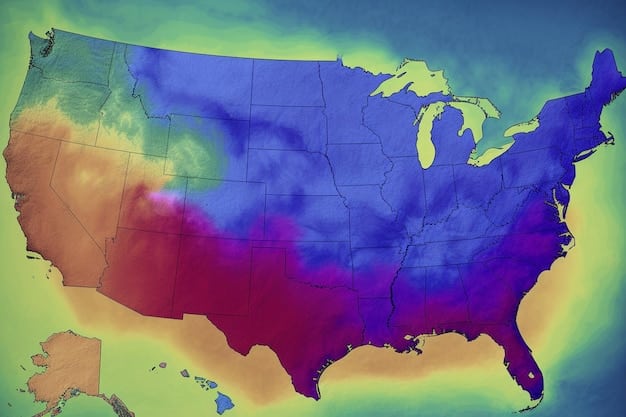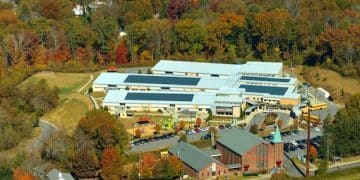White House Unveils New National Climate Strategy by 2030

The White House has officially announced a bold new national strategy aimed at significantly combating climate change by 2030, proposing comprehensive measures across various sectors to accelerate the transition to a sustainable, carbon-neutral economy while enhancing resilience to climatic impacts.
In a landmark move, the White House unveils new National Strategy to Combat Climate Change by 2030, signaling a pivotal shift in the nation’s approach to environmental sustainability. This comprehensive plan aims to redefine America’s role in the global fight against rising temperatures and extreme weather events. What critical new measures will shape the national landscape in the coming years?
Understanding the Urgency: Why 2030 is Critical
The year 2030 is not an arbitrary deadline; it represents a critical threshold identified by the scientific community for averting the most catastrophic impacts of climate change. Global reports, notably from the Intergovernmental Panel on Climate Change (IPCC), have consistently underscored the necessity of rapid and far-reaching transitions in energy, land, urban infrastructure, and industrial systems. Failing to achieve substantial reductions in greenhouse gas emissions by this decade could lock in irreversible changes, making adaptation far more challenging and costly.
The urgency stems from several interconnected factors. Accumulated emissions in the atmosphere have already committed the planet to a certain degree of warming. Every incremental increase in global temperatures amplifies the frequency and intensity of extreme weather events, disrupts ecosystems, threatens food security, and displaces populations. By setting a clear target for 2030, the White House strategy aligns with international scientific consensus and demonstrates a commitment to playing a proactive role in global climate action.
Scientific Consensus and Global Commitments
The scientific community’s understanding of climate change is robust and continually refined. Decades of research have established a clear link between human activities, increased greenhouse gas concentrations, and global warming. This consensus forms the bedrock of national and international climate policies. Furthermore, the 2030 target reflects an ambition to meet or exceed the commitments outlined in the Paris Agreement, where nations pledged to keep global temperature rise well below 2 degrees Celsius above pre-industrial levels, while pursuing efforts to limit the increase to 1.5 degrees Celsius.
- The IPCC’s special report on 1.5 degrees Celsius highlighted the distinct benefits of limiting warming to that level compared to 2 degrees Celsius, emphasizing the need for drastic emissions cuts by 2030.
- Many countries have already bolstered their Nationally Determined Contributions (NDCs) under the Paris Agreement, signaling a global shift towards more ambitious climate targets.
- Economic assessments increasingly show that the costs of inaction far outweigh the investments needed for climate mitigation and adaptation, making prudent climate policy a fiscal imperative.
This section underscores that the White House’s 2030 deadline is not just a political statement but a pragmatic response to scientific evidence and international obligations. It sets the stage for a dramatic transformation of the national economy and society, requiring unprecedented levels of cooperation across sectors and levels of government.
Key Pillars of the New National Strategy
The newly unveiled national strategy against climate change is built upon several foundational pillars, each designed to address a critical aspect of the crisis. From transitioning energy sources to fostering innovation, these pillars collectively aim to create a comprehensive and effective framework for decarbonization and resilience. The strategy recognizes that a multifaceted approach is essential, given the complex and systemic nature of climate change.
Central to these pillars is the concept of a “whole-of-government” approach, ensuring that climate considerations are integrated into policymaking across all federal agencies. This coordinated effort seeks to avoid fragmented initiatives and maximize the impact of the nation’s climate actions. Emphasis is also placed on environmental justice, ensuring that vulnerable communities disproportionately affected by pollution and climate impacts are prioritized in policy benefits and protected from adverse outcomes.
Accelerating Clean Energy Transition
A cornerstone of the strategy is the radical acceleration of the transition to clean energy. This involves not only scaling up renewable energy sources like solar and wind power but also modernizing the nation’s energy grid to support a distributed and resilient power system. Significant investments are earmarked for research and development into next-generation clean energy technologies, including advanced battery storage, green hydrogen, and carbon capture solutions. The goal is to make clean energy not just an environmental imperative but an economic advantage, creating jobs and fostering domestic manufacturing capabilities.
- Large-scale deployment of solar and wind farms, coupled with incentives for rooftop solar and community renewable projects.
- Development of a smart grid capable of handling intermittent renewable energy sources and integrating electric vehicles.
- Increased funding for energy efficiency programs in residential, commercial, and industrial sectors to reduce overall energy demand.
Enhancing Climate Resilience and Adaptation
Beyond mitigation, the strategy recognizes the urgent need for enhanced climate resilience and adaptation measures. Many communities across the U.S. are already experiencing the impacts of climate change, from more intense hurricanes and wildfires to prolonged droughts and rising sea levels. The plan outlines investments in resilient infrastructure, nature-based solutions, and early warning systems to protect lives, livelihoods, and critical assets. This proactive approach aims to minimize the damages from future climate events and ensure that communities can recover more quickly.
The strategy also focuses on strengthening climate information and services, providing state and local governments with the data and tools they need to make informed decisions about adaptation planning. This includes improving climate modeling, enhancing flood mapping, and developing tailored risk assessments for specific regions and sectors. Building a resilient nation requires a robust understanding of future climate risks and the capacity to integrate this knowledge into practical solutions.

Economic Impacts and Job Creation
The ambitious national climate strategy is envisioned as a powerful engine for economic growth and job creation, challenging the traditional narrative that environmental protection inevitably hinders economic prosperity. Instead, the White House frames this transition as an opportunity to modernize the American economy, foster innovation, and secure a competitive edge in emerging global industries. The focus is on channeling public and private investment into sectors that will drive the clean energy transition and build a more sustainable future.
This economic transformation is expected to generate millions of new jobs across various sectors, from manufacturing and construction to research and development. Investments in renewable energy, energy efficiency, clean transportation, and resilient infrastructure will create demand for skilled labor and foster new industries. The strategy emphasizes “good-paying union jobs,” aligning climate action with broader economic equity goals.
Green Jobs and Workforce Development
The concept of “green jobs” is central to the economic vision of the climate strategy. These are jobs in sectors directly related to environmental protection and the transition to a sustainable economy. This includes jobs in renewable energy installation and maintenance, energy efficiency auditing and upgrades, sustainable agriculture, waste management, and environmental remediation. To ensure a skilled workforce is available to fill these roles, the strategy outlines significant investments in workforce development programs, including apprenticeships, vocational training, and STEM education initiatives.
- Training programs focused on emerging clean energy technologies, such as solar panel installation, wind turbine maintenance, and battery manufacturing.
- Reskilling initiatives for workers in fossil fuel industries, providing pathways to new opportunities in the clean energy sector.
- Promoting diversity and inclusion in the green workforce, ensuring equitable access to these new economic opportunities.
Furthermore, the strategy considers the broader economic multipliers of these investments. As the clean energy sector expands, it will stimulate demand in ancillary industries, from raw material suppliers to financial services. The reduction in fossil fuel dependence is also projected to stabilize energy prices, reduce public health costs associated with air pollution, and enhance national energy security, providing indirect economic benefits that strengthen the overall economy.
Technological Innovations and Research Focus
Innovation lies at the heart of the White House unveils new National Strategy to Combat Climate Change by 2030. The sheer scale of the climate challenge necessitates groundbreaking technological advancements that can accelerate decarbonization across all sectors of the economy. The strategy commits significant federal resources to research, development, and demonstration (RD&D) programs, aiming to bring nascent technologies from the laboratory to large-scale commercial deployment. This focus on innovation is critical for achieving ambitious emissions reduction targets that might seem out of reach with current technologies.
A key aspect of this technological push is investing in diverse solutions. There is no single silver bullet for climate change; rather, a portfolio of technologies will be required, each optimized for different applications and sectors. This includes innovations in energy generation, storage, transmission, industrial processes, transportation, and carbon management. The strategy seeks to foster a dynamic ecosystem of public and private sector collaboration to drive these advancements.
Breakthroughs in Energy and Industrial Decarbonization
The strategy highlights specific areas for targeted RD&D funding. In the energy sector, efforts will focus on improving the efficiency and cost-effectiveness of renewable energy sources, developing long-duration energy storage solutions to address intermittency, and advancing grid modernization technologies. For industrial decarbonization, the focus is on developing low-carbon alternatives for heavy industries like steel, cement, and chemicals, which are currently among the most challenging sectors to abate.
- Research into advanced nuclear power, including small modular reactors (SMRs), as a reliable, carbon-free baseload power source.
- Development of direct air capture (DAC) technologies and other carbon removal solutions to actively remove CO2 from the atmosphere.
- Innovation in sustainable aviation fuels (SAFs) and alternative fuels for shipping to decarbonize hard-to-abate transportation sectors.
Moreover, the plan recognizes the importance of digital technologies, such as artificial intelligence and machine learning, in optimizing energy systems, predicting climate impacts, and managing complex environmental data. These computational tools can enhance the efficiency of existing infrastructure and accelerate the development of new solutions. By investing strategically in a broad spectrum of technological innovations, the White House aims to position the U.S. as a leader in the global clean energy economy and ensure that the nation has the tools necessary to meet its 2030 climate goals and beyond.

International Cooperation and Global Leadership
The climate crisis is inherently a global challenge, transcending national borders and requiring concerted international action. The White House’s new national strategy recognizes this fundamental truth and places a strong emphasis on international cooperation and American leadership on the global stage. After periods of perceived withdrawal from international climate efforts, the strategy signals a renewed commitment to multilateralism and shared responsibility in addressing the planet’s most pressing environmental threat.
This renewed focus on global engagement involves various diplomatic and economic initiatives. The U.S. aims to re-establish credibility as a climate leader, encouraging other major emitters to raise their own climate ambitions and providing support to developing nations in their transition to sustainable economies. This includes leveraging diplomatic channels, participating actively in international climate forums, and mobilizing financial resources to facilitate a global transition away from fossil fuels.
Working with Key Partners and Developing Nations
A significant component of the strategy involves working closely with international partners, including allies in Europe and Asia, to develop shared approaches to climate mitigation and adaptation. This collaboration can involve sharing best practices, coordinating research efforts, and establishing common standards for clean technologies. Special attention is also given to developing nations, many of whom are particularly vulnerable to climate impacts despite contributing minimally to historical emissions. The U.S. plans to increase its financial and technical assistance to these countries, helping them build resilient infrastructure, adopt clean energy, and adapt to changing climatic conditions.
- Rejoining and actively participating in international climate negotiations and agreements, such as the Paris Agreement.
- Promoting climate diplomacy through bilateral and multilateral engagements, encouraging stronger climate commitments from other nations.
- Mobilizing public and private finance for climate initiatives in developing countries, including support for renewable energy projects and climate resilient infrastructure.
The strategy acknowledges that global climate success requires a collective effort, and no single nation can solve the crisis alone. By assuming a leadership role, fostering collaboration, and providing tangible support to nations worldwide, the White House aims to accelerate the global transition to a sustainable future. This not only benefits the planet but also serves U.S. economic and security interests by creating new markets for clean technologies and mitigating geopolitical instability driven by climate impacts.
Challenges and Criticisms Ahead
While the White House’s new national strategy to combat climate change by 2030 is ambitious and comprehensive, it is not without its challenges and criticisms. Implementing such a far-reaching plan requires overcoming significant political, economic, and logistical hurdles. The success of the strategy will depend largely on sustained political will, bipartisan support, and the ability to adapt to unforeseen obstacles. Skepticism from various quarters, including industry groups, certain political factions, and even some environmental advocates, suggests that the path forward will be complex.
One of the primary challenges lies in securing consistent funding and legislative support over an extended period. Climate policies often face resistance due to perceived costs to businesses or consumers, even when evidence suggests long-term economic benefits. Furthermore, the sheer scale of transforming energy systems, industrial processes, and transportation networks within a decade is an enormous undertaking, requiring unprecedented coordination and swift action across all levels of government and the private sector.
Political Will and Implementation Hurdles
Maintaining political will across different administrations and legislative cycles will be crucial. Climate policy can be highly susceptible to political shifts, with drastic changes in approach occurring after elections. The strategy’s long-term effectiveness hinges on institutionalizing climate action beyond a single administration’s tenure. Moreover, implementation hurdles include regulatory complexities, permitting challenges for new infrastructure, and the need to quickly scale up new technologies and supply chains.
- Potential for partisan stalemates in Congress affecting funding and legislative progress for climate initiatives.
- Resistance from entrenched industries and labor unions concerned about job losses or economic disruption during the transition.
- Challenges in rapidly building out new clean energy infrastructure, including transmission lines and charging networks, due to local opposition or bureaucratic delays.
Critics also raise concerns about the pace and scope of the proposed changes. Some argue that the strategy, while ambitious, may still not be aggressive enough to meet the 1.5-degree Celsius target, given the current trajectory of global emissions. Others worry about the potential for environmental justice shortcomings, ensuring that the benefits of the clean energy transition are equitably distributed and that no communities are left behind or disproportionately burdened. Addressing these challenges will require continuous stakeholder engagement, adaptive policy-making, and a persistent commitment to the stated goals, making transparency and accountability paramount throughout the implementation process.
The Path Forward: Monitoring and Adaptive Management
The success of the White House Unveils New National Strategy to Combat Climate Change by 2030 will depend not only on its initial unveiling but also on robust monitoring, evaluation, and adaptive management. Climate change is a dynamic challenge, and the strategies to combat it must be equally flexible and responsive. The path forward involves establishing clear metrics for progress, regularly assessing the effectiveness of policies, and being prepared to adjust course based on new data, scientific understanding, and emerging technological capabilities.
A critical element of this forward-looking approach is transparency. Regularly reporting on emissions reductions, clean energy deployment, and resilience building will be essential for maintaining public trust and demonstrating accountability. This accountability will extend to holding various sectors and government agencies responsible for meeting their specific targets within the broader national strategy. Ultimately, the plan is not a static document but a living framework designed to evolve as circumstances change.
Measuring Progress and Adapting Policies
To ensure the strategy remains on track, a comprehensive system for measuring progress will be put in place. This will involve tracking key indicators such as greenhouse gas emissions, renewable energy capacity additions, electric vehicle adoption rates, and investments in climate-resilient infrastructure. Data collection and analysis will be continuous, providing timely insights into what is working and what needs adjustment. Independent assessments and feedback from scientific bodies and stakeholder groups will also play a vital role in informing policy refinements.
- Establishment of clear, quantifiable targets for each sector and initiative, with regular reporting mechanisms.
- Ongoing scientific assessments to ensure policies are aligned with the latest climate science and risks.
- Mechanisms for public and stakeholder input, allowing for a democratized process of policy evaluation and adaptation.
Moreover, adaptive management implies a willingness to innovate within the strategy itself. If certain approaches prove less effective than anticipated, or if new, more efficient solutions emerge, the administration will need the flexibility to pivot and reallocate resources accordingly. This proactive stance on learning and adjustment is vital for a challenge as complex and rapidly evolving as climate change. The ultimate goal is to create a durable and effective framework that not only meets the 2030 targets but also lays the groundwork for a carbon-neutral and climate-resilient future beyond the current decade, ensuring long-term prosperity and environmental stability for the nation.
| Key Aspect | Brief Description |
|---|---|
| 🌍 2030 Target | Aims for significant emissions cuts by 2030, aligning with global climate science and Paris Agreement goals. |
| ⚡ Clean Energy Focus | Accelerates transition to renewables, modernizes grid, and invests in next-gen energy tech. |
| 🛡️ Resilience & Adaptation | Boosts resilient infrastructure and early warning systems to protect communities from climate impacts. |
| 🤝 Global Leadership | Re-engages in international climate diplomacy, supporting global efforts and vulnerable countries. |
Frequently Asked Questions About the New Climate Strategy
▼
The primary goal is to significantly combat climate change by 2030 through substantial reductions in greenhouse gas emissions and enhanced national resilience. It aims to align U.S. efforts with international scientific recommendations to limit global warming, foster a clean energy economy, and protect communities from direct climate impacts.
▼
The strategy is projected to stimulate economic growth by creating millions of new clean energy jobs across various sectors, including manufacturing, construction, and research. It aims to drive innovation, make the U.S. a leader in new green technologies, and reduce reliance on volatile fossil fuel markets, providing long-term economic benefits.
▼
Technological innovations are central to the strategy, with significant federal investment in R&D for next-generation clean energy, carbon capture, and industrial decarbonization solutions. The goal is to develop and scale breakthrough technologies that can accelerate emissions reductions and enhance climate adaptation capabilities across all sectors.
▼
Yes, the strategy places a strong emphasis on renewed U.S. leadership in international climate cooperation. It involves active participation in global climate forums, working with key allies, and providing increased financial and technical assistance to developing nations to help them transition to sustainable economies and build climate resilience.
▼
Key challenges include securing sustained political will and consistent funding across administrations, overcoming potential resistance from entrenched industries, and navigating complex regulatory and logistical hurdles in scaling up new infrastructure and technologies. Ensuring equitable distribution of benefits and addressing environmental justice concerns also remains a significant challenge.
Conclusion
The White House Unveils New National Strategy to Combat Climate Change by 2030 marks a decisive turning point in the nation’s approach to its most pressing environmental challenge. This comprehensive framework, designed with the urgency of scientific consensus and global commitments in mind, aims to fundamentally reshape the American economy and infrastructure. By prioritizing clean energy transition, bolstering climate resilience, fostering technological innovation, and re-establishing global leadership, the strategy lays out an ambitious yet necessary path toward a sustainable future. While significant challenges lie ahead in its implementation, the commitment to adaptive management and transparent progress monitoring offers hope that this vital initiative can achieve its transformative goals, ensuring a healthier planet and a more prosperous nation for generations to come.





